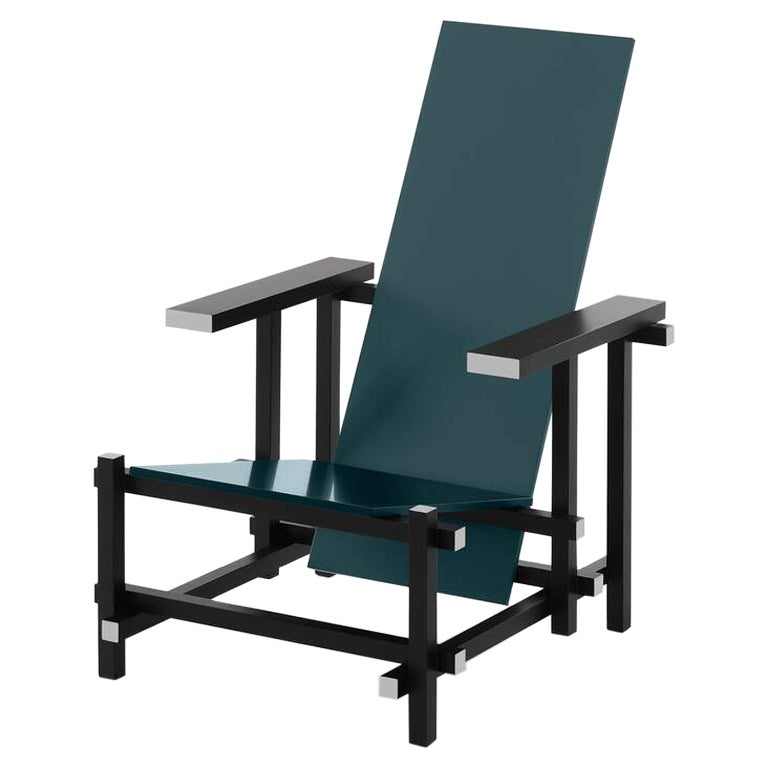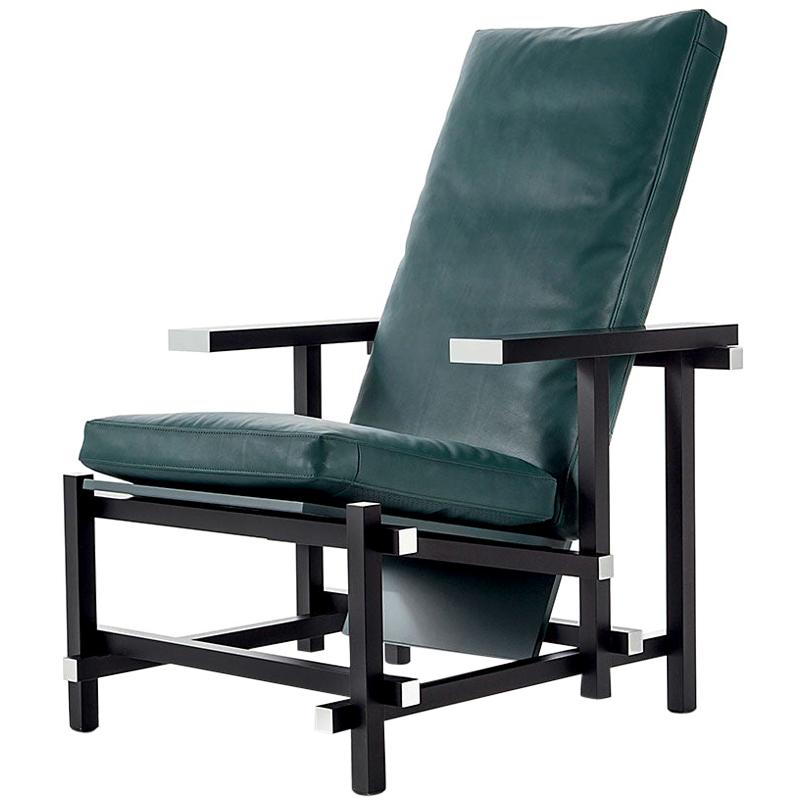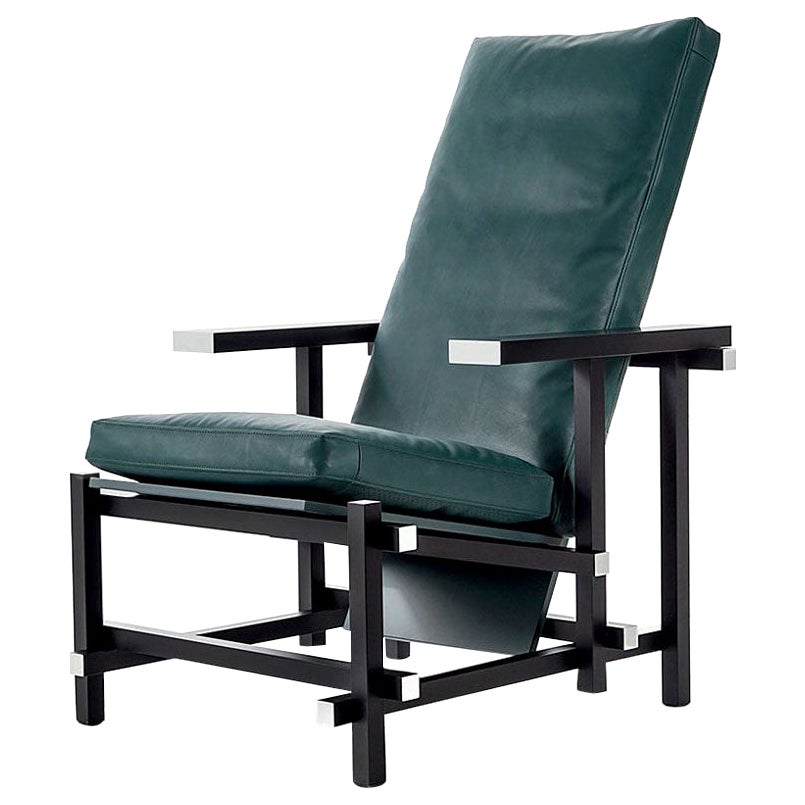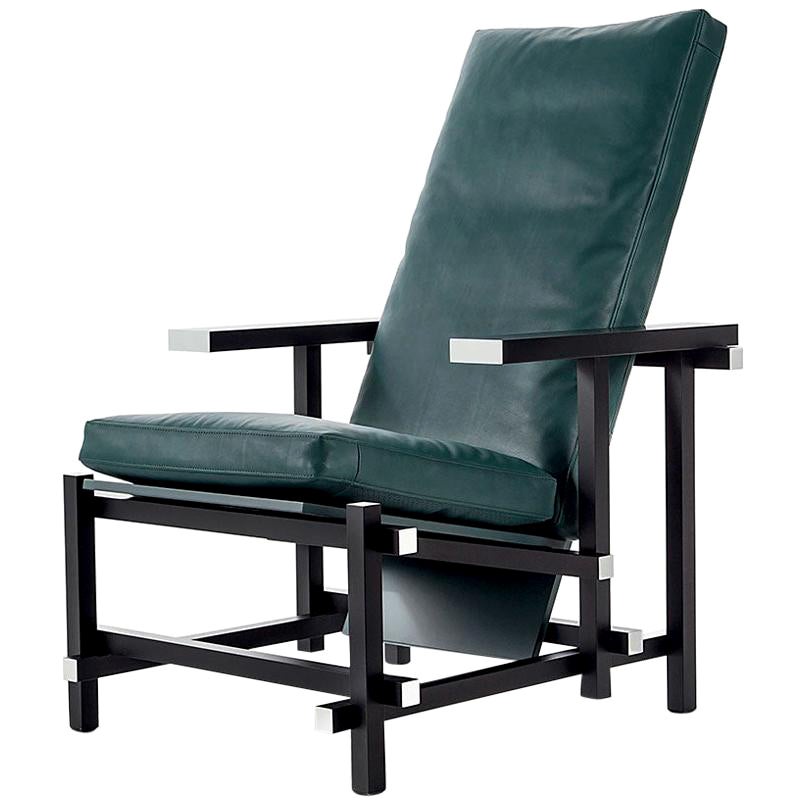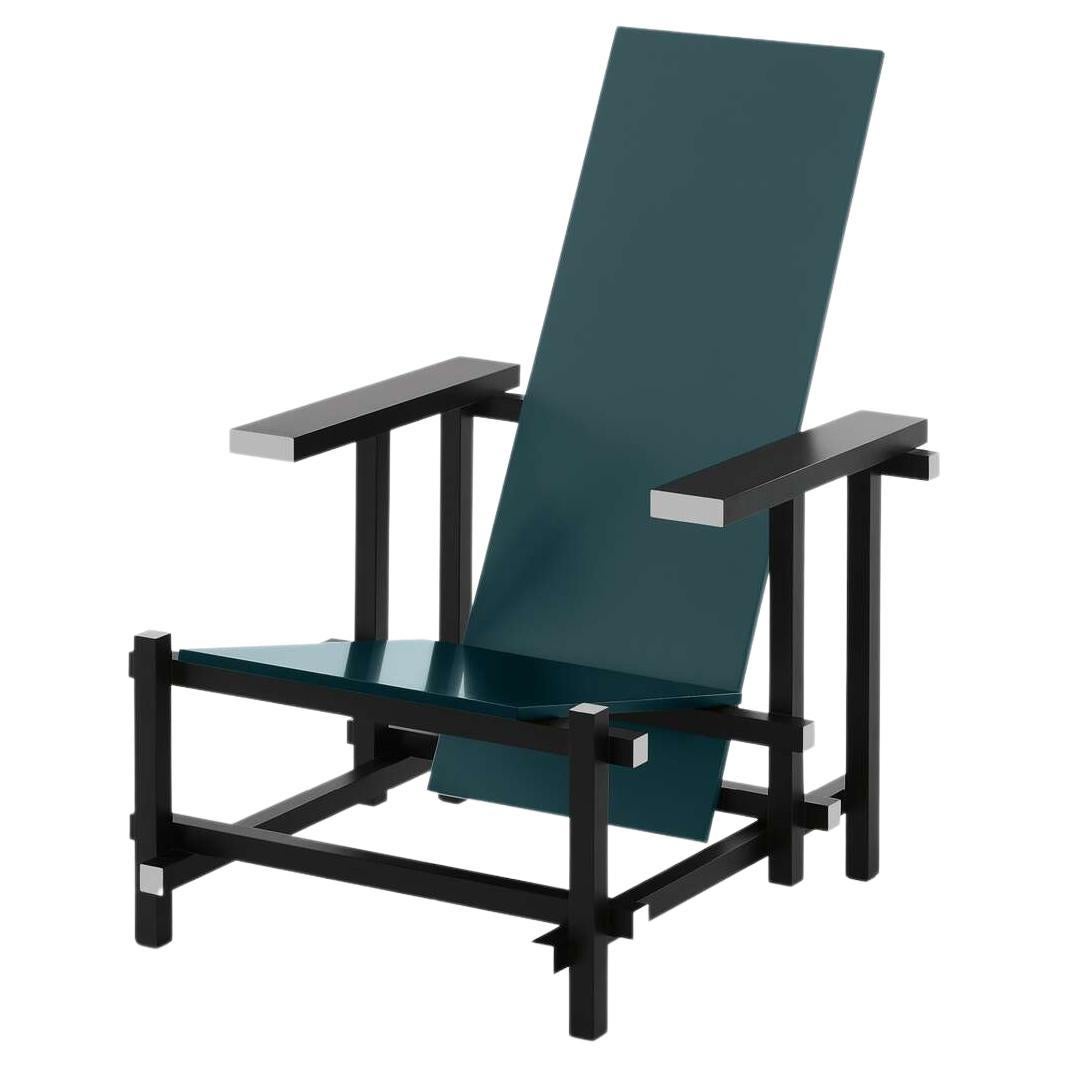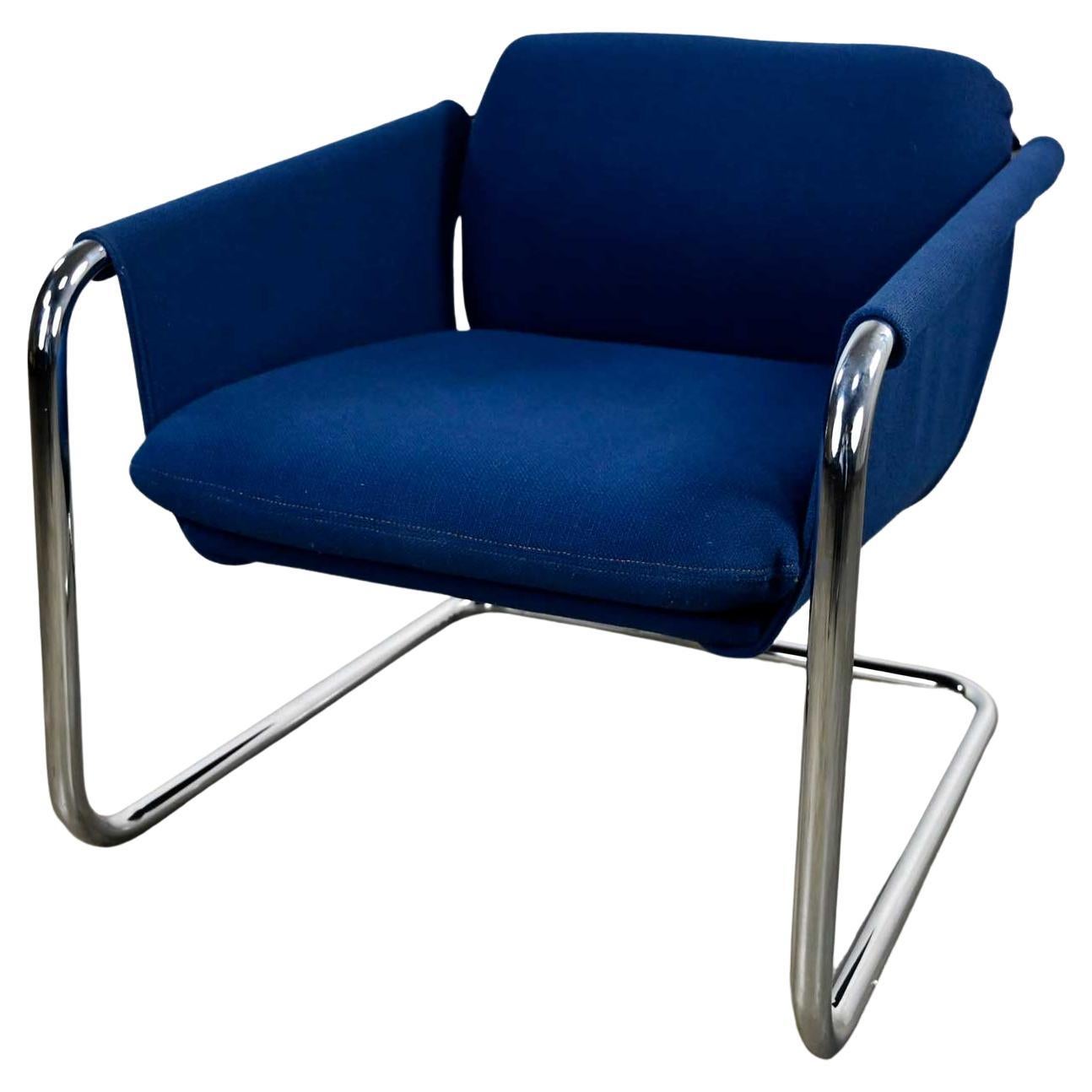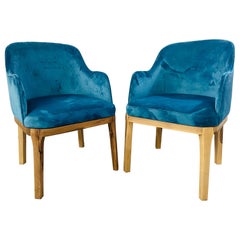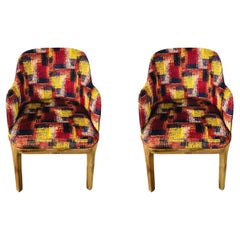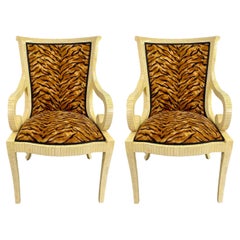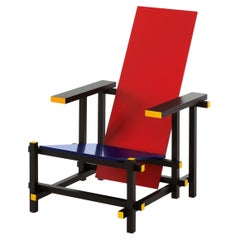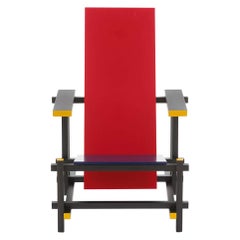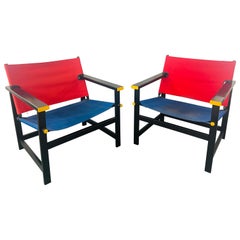
Mondrian Red and Blue Style Sling Chair, a Pair
View Similar Items
Want more images or videos?
Request additional images or videos from the seller
1 of 16
Mondrian Red and Blue Style Sling Chair, a Pair
About the Item
- Similar to:Gerrit Rietveld (Designer)
- Dimensions:Height: 25 in (63.5 cm)Width: 25 in (63.5 cm)Length: 25 in (63.5 cm)Seat Height: 13.5 in (34.29 cm)
- Sold As:Set of 2
- Style:De Stijl (In the Style Of)
- Materials and Techniques:
- Period:
- Date of Manufacture:1980s
- Condition:Wear consistent with age and use. Minor fading. Some fading to the seat textile blue color as shown on the picture.
- Seller Location:Plainview, NY
- Reference Number:Seller: AS-JW021stDibs: LU5060222664122
About the Seller
5.0
Platinum Seller
These expertly vetted sellers are 1stDibs' most experienced sellers and are rated highest by our customers.
Established in 2014
1stDibs seller since 2019
276 sales on 1stDibs
More From This SellerView All
- Mid-Century Modern Style Blue Velvet & Walnut Frame Barrel Chair, a PairLocated in Plainview, NYA stylish pair of Mid Century Modern style barrel chairs. The chairs feature a recent upholstery in an electric vivid blue velvet. a highly desirable and fashionable color. The high quality chairs are made of walnut wood. The natural color of the walnut wood showing burl patterns adds to the chairs beauty and elegance. This pair of MCM style chairs...Category
Late 20th Century European Mid-Century Modern Armchairs
MaterialsUpholstery, Velvet, Walnut
- Mid-Century Modern Style Chair Multicolor Upholstery and Walnut Frame, a PairLocated in Plainview, NYA stylish pair of Mid Century Modern style barrel chairs. The chairs feature a recent upholstery in vivid dark blue, yellow and cranberry colors. The high quality chairs are made of walnut wood. The natural color of the walnut wood showing burl patterns adds to the chairs beauty and elegance. This pair of MCM style chairs...Category
1990s Mid-Century Modern Armchairs
MaterialsUpholstery, Walnut
$1,800 Sale Price / set40% Off - Enrique Garcel Off-White Bone Lounge Chair or Armchair, a PairBy Enrique GarcelLocated in Plainview, NYPair of Enrique Garcel off-white bone style armchairs. Each tessellated form armchair with scrolling arm and body type. Both stylish and sleek showing off a nice leopard upholstery f...Category
Late 20th Century Colombian Mid-Century Modern Armchairs
MaterialsBone, Fabric
$2,500 Sale Price / set31% Off - Mid Century Boho Chic Faux Bamboo Rattan ChairLocated in Plainview, NYA quality Mid Century Boho Chic faux bamboo and Rattan armchair. Finely carved , the chair features curved arms resting on a rattan seat. The back of the chair is slightly curved pro...Category
Mid-20th Century Bohemian Armchairs
MaterialsFaux Bamboo, Rattan
- Jacobean Style Oak Carved Berger or Arm Chair with Red Upholstery, a PairLocated in Plainview, NYA pair of classic Jacobean style arm or Berger chairs. The chairs are hand-carved of high quality oak and show elegant geometrical motifs. The chairs feature serpentine crest rail an...Category
20th Century Jacobean Armchairs
MaterialsUpholstery, Oak
$1,200 Sale Price / set53% Off - French Empire Style Mahogany & Leather Saber Legs Dining Chair, A Set of 8Located in Plainview, NYA stunning French Empire Style set of 8 dinning chairs. The chairs are made of quality Mahogany wood. The frame is exquisitely hand carved and shows a...Category
Late 20th Century French Empire Dining Room Chairs
MaterialsLeather, Mahogany
You May Also Like
- Gerrit Rietveld Red and Blue Chair by CassinaBy Cassina, Gerrit RietveldLocated in Barcelona, BarcelonaChair designed by Gerrit Rietveld in 1918. Relaunched in 1973. Manufactured by Cassina in Italy. A sculptural seat with a pure and rationalist form, this chair became an authentic Manifesto for Neoplasticism, embraced by the Dutch De Stijl movement in 1917. An outlook shared by Piet Mondrian, whose objective was to seek out the essential nature of things, combined with the harmonious equivalence of colours, and the use of right-angle. Rietveld produced his first prototypes in 1918, expressing the philosophy of organising space using the same colours for similar components. He later applied this same approach to separate out constructional elements according to their function. Thus the base was black, and the seats coloured. As a consequence, the name of the piece changed, from Slat Chair to Red and Blue. Important information regarding images of products: Please note that some of the images show other colors and variations of the model, these images are only to present interior design proposals. The item that is selling is on the first image. Important information regarding color(s) of products: Actual colors may vary. This is due to the fact that every computer monitor, laptop, tablet and phone screen has a different capability to display colors and that everyone sees these colors differently. We try to edit our photos to show all of our products as life-like as possible, but please understand the actual color may vary slightly from your monitor About the designer: Gerrit Thomas Rietveld, born in Utrecht on 24 June 1888, seems possessed of two personalities, each so distinct that one might take his work to be that of more than one artist. The first personality is that seen in the craftsman cabinet-maker working in a primordial idiom, re-inventing chairs and other furniture as if no one had ever built them before him and following a structural code all of his own; the second is that of the architect working with elegant formulas, determined to drive home the rationalist and neoplastic message in the context of European architecture. The two activities alternate, overlap, and fuse in a perfect osmosis unfolding then into a logical sequence. In 1918 Rietveld joined the “De Stijl” movement which had sprung up around the review of that name founded the year before by Theo van Doesburg. The group assimilated and translated into ideology certain laws on the dynamic breakdown of compositions (carrying them to an extreme) that had already been expressed in painting by the cubists: the “De Stijl” artists also carefully studied the architectonic lesson taught by the great Frank Lloyd Wright, whose influence was widely felt in Europe at that time. Collaborating first with Robert van’t Hoff and Vilmos Huszar...Category
2010s Italian Mid-Century Modern Armchairs
MaterialsWood
$5,316 / item - Gerrit Rietveld Red and Blue Chair for Cassina, Italy, newBy Gerrit Rietveld, CassinaLocated in Berlin, DEChair designed by Gerrit Rietveld in 1918. Relaunched in 1973. Manufactured by Cassina in Italy.Category
21st Century and Contemporary Italian Chairs
MaterialsWood
- Gerrit Rietveld Zeilmaker Version of Black Red and Blue Chair by CassinaBy Cassina, Gerrit RietveldLocated in Barcelona, BarcelonaChair designed by Gerrit Rietveld in 1920. Relaunched in 2015. Manufactured by Cassina in Italy. One of the versions of the iconic model dated 1918. The structure is in black-stained beechwood with white contrasting parts. Seat and back in green lacquered multiplywood. The black red and blue (Zeilmaker version) born from Rietveld’s chromatic experimentation While researching the origins of the red and blue model in collaboration with the Rietveld heirs, it emerged that the key idea of the first prototypes was based on the concept of spatial organization expressed through the monochrome tones of its elements. The first version was in fact produced in 1918 in completely unpainted wood. In the following years Rietveld proposed various examples, either monochrome or painted in different colors, depending on the requirements of his customers and the interiors for which the chairs were intended. As such, it comes as no surprise to find this 1920s version, presented as part of Cassina’s MutAzioni selection, created for the school teacher Wicher Zeilmaker with a black frame with white ends and a dark green painted seat and backrest. It was Rietveld’s ever-increasing involvement in the De Stijl movement that led him to also use primary colors on this model in 1923, and as such the chair became a veritable manifesto for the emerging neoplastic movement. Initially dubbed slat chair, Rietveld only gave it the name red and blue in the 1950s following its chromatic evolution. The various owners of the different examples used the chair as an abstract-realist sculpture in their interiors and, in some cases, as a simple tool for sitting on, adding cushions to make it more comfortable, just like Cassina offers for the black red and blue today. Important information regarding images of products: Please note that some of the images show other colors and variations of the model, these images are only to present interior design proposals. The item that is selling is on the first image. Important information regarding color(s) of products: Actual colors may vary. This is due to the fact that every computer monitor, laptop, tablet and phone screen has a different capability to display colors and that everyone sees these colors differently. We try to edit our photos to show all of our products as life-like as possible, but please understand the actual color may vary slightly from your monitor About the designer: Gerrit Thomas Rietveld, born in Utrecht on 24 June 1888, seems possessed of two personalities, each so distinct that one might take his work to be that of more than one artist. The first personality is that seen in the craftsman cabinet-maker working in a primordial idiom, re-inventing chairs and other furniture as if no one had ever built them before him and following a structural code all of his own; the second is that of the architect working with elegant formulas, determined to drive home the rationalist and neoplastic message in the context of European architecture. The two activities alternate, overlap, and fuse in a perfect osmosis unfolding then into a logical sequence. In 1918 Rietveld joined the “De Stijl” movement which had sprung up around the review of that name founded the year before by Theo van Doesburg. The group assimilated and translated into ideology certain laws on the dynamic breakdown of compositions (carrying them to an extreme) that had already been expressed in painting by the cubists: the “De Stijl” artists also carefully studied the architectonic lesson taught by the great Frank Lloyd Wright, whose influence was widely felt in Europe at that time. Collaborating first with Robert van’t Hoff and Vilmos Huszar, then with Theo van Doesburg and Cornelius van Eesteren, Rietveld soon became one of the most distinguished interpreters of the neoplastic message. Among his most important works are: the Schröder house at Utrecht (1924); the “Row Houses” at Utrecht (1931-1934); the Dutch pavilion at the Venice Biennial (1954); the sculpture pavilion in the Rijksmuseum Kröller-Müller at Otterloo and the Van Gogh Museum in Amsterdam (1955). Out of his equally important furniture, Cassina has chosen for its own production: the “Red and Blue” (1918), the “Zig-Zag” (1934), the “Schröder 1...Category
2010s Italian Mid-Century Modern Armchairs
MaterialsLeather, Wood
- Gerrit Rietveld Zeilmaker Version of Black Red and Blue Chair by CassinaBy Cassina, Gerrit RietveldLocated in Barcelona, BarcelonaChair designed by Gerrit Rietveld in 1920. Relaunched in 2015. Manufactured by Cassina in Italy. One of the versions of the iconic model dated 1918. The structure is in black-stained beechwood with white contrasting parts. Seat and back in green lacquered multiplywood. The armchair can have a single seat and backrest cushion in fabric or leather. The black red and blue (Zeilmaker version) born from Rietveld’s chromatic experimentation While researching the origins of the red and blue model in collaboration with the Rietveld heirs, it emerged that the key idea of the first prototypes was based on the concept of spatial organization expressed through the monochrome tones of its elements. The first version was in fact produced in 1918 in completely unpainted wood. In the following years Rietveld proposed various examples, either monochrome or painted in different colors, depending on the requirements of his customers and the interiors for which the chairs were intended. As such, it comes as no surprise to find this 1920s version, presented as part of Cassina’s MutAzioni selection, created for the school teacher Wicher Zeilmaker with a black frame with white ends and a dark green painted seat and backrest. It was Rietveld’s ever-increasing involvement in the De Stijl movement that led him to also use primary colors on this model in 1923, and as such the chair became a veritable manifesto for the emerging neoplastic movement. Initially dubbed slat chair, Rietveld only gave it the name red and blue in the 1950s following its chromatic evolution. The various owners of the different examples used the chair as an abstract-realist sculpture in their interiors and, in some cases, as a simple tool for sitting on, adding cushions to make it more comfortable, just like Cassina offers for the black red and blue today. Production delay: 8-9 weeks Important information regarding images of products: Please note that some of the images show other colors and variations of the model, these images are only to present interior design proposals. The item that is selling is on the first image. Important information regarding color(s) of products: Actual colors may vary. This is due to the fact that every computer monitor, laptop, tablet and phone screen has a different capability to display colors and that everyone sees these colors differently. We try to edit our photos to show all of our products as life-like as possible, but please understand the actual color may vary slightly from your monitor About the designer: Gerrit Thomas Rietveld, born in Utrecht on 24 June 1888, seems possessed of two personalities, each so distinct that one might take his work to be that of more than one artist. The first personality is that seen in the craftsman cabinet-maker working in a primordial idiom, re-inventing chairs and other furniture as if no one had ever built them before him and following a structural code all of his own; the second is that of the architect working with elegant formulas, determined to drive home the rationalist and neoplastic message in the context of European architecture. The two activities alternate, overlap, and fuse in a perfect osmosis unfolding then into a logical sequence. In 1918 Rietveld joined the “De Stijl” movement which had sprung up around the review of that name founded the year before by Theo van Doesburg. The group assimilated and translated into ideology certain laws on the dynamic breakdown of compositions (carrying them to an extreme) that had already been expressed in painting by the cubists: the “De Stijl” artists also carefully studied the architectonic lesson taught by the great Frank Lloyd Wright, whose influence was widely felt in Europe at that time. Collaborating first with Robert van’t Hoff and Vilmos Huszar, then with Theo van Doesburg and Cornelius van Eesteren, Rietveld soon became one of the most distinguished interpreters of the neoplastic message. Among his most important works are: the Schröder house at Utrecht (1924); the “Row Houses” at Utrecht (1931-1934); the Dutch pavilion at the Venice Biennial (1954); the sculpture pavilion in the Rijksmuseum Kröller-Müller at Otterloo and the Van Gogh Museum in Amsterdam (1955). Out of his equally important furniture, Cassina has chosen for its own production: the “Red and Blue” (1918), the “Zig-Zag” (1934), the “Schröder 1...Category
2010s Italian Mid-Century Modern Armchairs
MaterialsWood, Leather
$6,510 Sale Price / item20% Off - Gerrit Rietveld Zeilmaker Version of Black Red and Blue Chair by CassinaBy Cassina, Gerrit RietveldLocated in Barcelona, BarcelonaChair designed by Gerrit Rietveld in 1920. Relaunched in 2015. Manufactured by Cassina in Italy. One of the versions of the iconic model dated 1918. The structure is in black-stained beechwood with white contrasting parts. Seat and back in green lacquered multiplywood. The armchair can have a single seat and backrest cushion in fabric or leather. The black red and blue (Zeilmaker version) born from Rietveld’s chromatic experimentation While researching the origins of the red and blue model in collaboration with the Rietveld heirs, it emerged that the key IDEA of the first prototypes was based on the concept of spatial organization expressed through the monochrome tones of its elements. The first version was in fact produced in 1918 in completely unpainted wood. In the following years Rietveld proposed various examples, either monochrome or painted in different colors, depending on the requirements of his customers and the interiors for which the chairs were intended. As such, it comes as no surprise to find this 1920s version, presented as part of Cassina’s MutAzioni selection, created for the school teacher Wicher Zeilmaker with a black frame with white ends and a dark green painted seat and backrest. It was Rietveld’s ever-increasing involvement in the De Stijl movement that led him to also use primary colors on this model in 1923, and as such the chair became a veritable manifesto for the emerging neoplastic movement. Initially dubbed slat chair, Rietveld only gave it the name red and blue in the 1950s following its chromatic evolution. The various owners of the different examples used the chair as an abstract-realist sculpture in their interiors and, in some cases, as a simple tool for sitting on, adding cushions to make it more comfortable, just like Cassina offers for the black red and blue today. Important information regarding images of products: Please note that some of the images show other colors and variations of the model, these images are only to present interior design proposals. The item that is selling is on the first image. Important information regarding color(s) of products: Actual colors may vary. This is due to the fact that every computer monitor, laptop, tablet and phone screen has a different capability to display colors and that everyone sees these colors differently. We try to edit our photos to show all of our products as life-like as possible, but please understand the actual color may vary slightly from your monitor About the designer: Gerrit Thomas Rietveld, born in Utrecht on 24 June 1888, seems possessed of two personalities, each so distinct that one might take his work to be that of more than one artist. The first personality is that seen in the craftsman cabinet-maker working in a primordial idiom, re-inventing chairs and other furniture as if no one had ever built them before him and following a structural code all of his own; the second is that of the architect working with elegant formulas, determined to drive home the rationalist and neoplastic message in the context of European architecture. The two activities alternate, overlap, and fuse in a perfect osmosis unfolding then into a logical sequence. In 1918 Rietveld joined the “De Stijl” movement which had sprung up around the review of that name founded the year before by Theo van Doesburg. The group assimilated and translated into ideology certain laws on the dynamic breakdown of compositions (carrying them to an extreme) that had already been expressed in painting by the cubists: the “De Stijl” artists also carefully studied the architectonic lesson taught by the great Frank Lloyd Wright, whose influence was widely felt in Europe at that time. Collaborating first with Robert van’t Hoff and Vilmos Huszar, then with Theo van Doesburg and Cornelius van Eesteren, Rietveld soon became one of the most distinguished interpreters of the neoplastic message. Among his most important works are: the Schröder house at Utrecht (1924); the “Row Houses” at Utrecht (1931-1934); the Dutch pavilion at the Venice Biennial (1954); the sculpture pavilion in the Rijksmuseum Kröller-Müller at Otterloo and the Van Gogh Museum in Amsterdam (1955). Out of his equally important furniture, Cassina has chosen for its own production: the “Red and Blue” (1918), the “Zig-Zag” (1934), the “Schröder 1...Category
2010s Italian Mid-Century Modern Armchairs
MaterialsLeather, Wood
- Gerrit Rietveld Zeilmaker Version of Black Red and Blue Chair by CassinaBy Cassina, Gerrit RietveldLocated in Barcelona, BarcelonaChair designed by Gerrit Rietveld in 1920. Relaunched in 2015. Manufactured by Cassina in Italy. One of the versions of the iconic model dated 1918. The structure is in black-stained beechwood with white contrasting parts. Seat and back in green lacquered multiplywood. The black red and blue (Zeilmaker version) born from Rietveld’s chromatic experimentation While researching the origins of the red and blue model in collaboration with the Rietveld heirs, it emerged that the key idea of the first prototypes was based on the concept of spatial organization expressed through the monochrome tones of its elements. The first version was in fact produced in 1918 in completely unpainted wood. In the following years Rietveld proposed various examples, either monochrome or painted in different colors, depending on the requirements of his customers and the interiors for which the chairs were intended. As such, it comes as no surprise to find this 1920s version, presented as part of Cassina’s MutAzioni selection, created for the school teacher Wicher Zeilmaker with a black frame with white ends and a dark green painted seat and backrest. It was Rietveld’s ever-increasing involvement in the De Stijl movement that led him to also use primary colors on this model in 1923, and as such the chair became a veritable manifesto for the emerging neoplastic movement. Initially dubbed slat chair, Rietveld only gave it the name red and blue in the 1950s following its chromatic evolution. The various owners of the different examples used the chair as an abstract-realist sculpture in their interiors and, in some cases, as a simple tool for sitting on, adding cushions to make it more comfortable, just like Cassina offers for the black red and blue today. Important information regarding images of products: Please note that some of the images show other colors and variations of the model, these images are only to present interior design proposals. The item that is selling is on the first image. Important information regarding color(s) of products: Actual colors may vary. This is due to the fact that every computer monitor, laptop, tablet and phone screen has a different capability to display colors and that everyone sees these colors differently. We try to edit our photos to show all of our products as life-like as possible, but please understand the actual color may vary slightly from your monitor About the designer: Gerrit Thomas Rietveld, born in Utrecht on 24 June 1888, seems possessed of two personalities, each so distinct that one might take his work to be that of more than one artist. The first personality is that seen in the craftsman cabinet...Category
2010s Italian Mid-Century Modern Armchairs
MaterialsLeather, Wood
Recently Viewed
View AllMore Ways To Browse
Pair Sling Armchairs
T Sling
Gerrit Rietveld Red Blue Chair
Gerrit Rietveld Red And Blue Chair
Red Blue Chair By Gerrit Rietveld
Pair Of Gerrit Rietveld Chairs
Red And Blue Chair By Gerrit Rietveld
T Sling Chair
Late 20th Century Textile Armchairs
Gerrit T Rietveld
Mondrian Chair
Mondrian Style Chair
Wood Frame Arm Chair
Midcentury Upholstered Arm Chair
Mid Century Wood Framed Armchairs
Upholstered Victorian
Single Armchairs
Long Armchair


